Sawtooth has been around since 1884. It's a four-patch, meaning the number of mini-blocks in a block grid is always a multiple of four. That in turn means that a seam can go through the center of the star. A classic Sawtooth has a plain center patch, but some variations don't.
Sawtooth
 Sawtooth
Ladies Art Co. #1 Sawtooth
Ladies Art Co. #1
1897
 Evening Star/Ann's Doll Quilt/Cluster of Stars/Square & Points/8-pointed Star/Nameless Star/Saw Tooth/Variable Star Evening Star/Ann's Doll Quilt/Cluster of Stars/Square & Points/8-pointed Star/Nameless Star/Saw Tooth/Variable Star
This venerable star's name dates back to an 1884 issue of a magazine called Farm & Fireside, according to Jinny Beyer's Quilter's Album. More than a dozen years later, the Ladies Art Company called it Evening Star (Block #5, 1897). Despite collecting seven more names, the block still usually goes by Sawtooth.
|
|
Joining Star
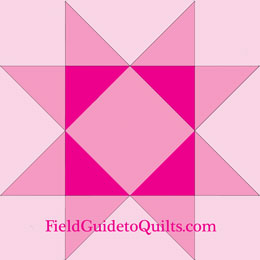 Joining Star
Page Joining Star
Page
1934

Joining Star was a tiny part of a quilt called "Quilt of Many Stars," designed by Nancy Page. It was published in 1934 by the St. Louis Star-Times as part of the Nancy Page Quilt Club series.
The quilt is a windowpane style, with "sashing" of contrasting fabric separating each block. This sweet little star was in the intersections of the sashing pieces, joining them together.
When it was first published, Joining Star was identical to Ribbon Star except for the seams. It was published in just two colors, like Ribbon Star. We've branched out here because — why not? |
|
Ribbon Star
   
   
   
   
Ribbon Star
 Ribbon Star
LAC, #268 Ribbon Star
LAC, #268
1897  The Ladies Art Company's Ribbon Star (#268) was published exactly as we show it at left. The drawing left quilters all at sea about whether they should make those oddly shaped pieces (dark pink in our graphic at left) as a four individual pieces or by sewing three quarter-square triangles together for each one. A curious quilter practically had to order a diagram (5 cents in 1928) or a pattern (15 cents in 1928). That's marketing for ya. The Ladies Art Company's Ribbon Star (#268) was published exactly as we show it at left. The drawing left quilters all at sea about whether they should make those oddly shaped pieces (dark pink in our graphic at left) as a four individual pieces or by sewing three quarter-square triangles together for each one. A curious quilter practically had to order a diagram (5 cents in 1928) or a pattern (15 cents in 1928). That's marketing for ya.
We tend to think that each of the funny-shaped pieces was made of three quarter-square triangles. But they could also be split down the center, as if by a diagonal seam. |
|
Odd Fellow's Cross
 Odd Fellow's Cross Odd Fellow's Cross
Finley, 1929
Odd Fellows clubs were once rural England's version of trade guilds, which in turn were predecessors of today's unions.
"Fellows" were skilled laborers, such as blacksmiths and carpenters. "Odd" fellows were those in the countryside, too distant from each other to form a single-specialty guild. Instead, they formed clubs with other local tradesmen.
Odd Fellows clubs date back well before the earliest documentation of the group in 1730. In Finley's time, there were many Odd Fellows' clubs in the countryside.
The Odd Fellow's Cross block got its name before 1933, when the same block showed up in a Kansas City Star under the name The Ozark Trail. The contributor named it after "the jagged and rocky outline of trails" in the Ozark mountains. The Sawtooth shape is outlined in the seams.
There is one other Odd Fellows block on this site: 
|
|
Odd Fellow's Cross
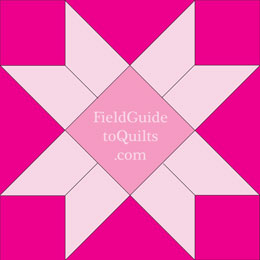 Odd Fellow's Cross Odd Fellow's Cross
Ickess, 1949
Most of us associate Odd Fellows with a three-link chain, the most prominent symbol of the group, which still exists, albeit in a loosely organized form.
None of the quilt blocks we've seen link to that or any other recognizable Odd Fellows symbol.
The construction is similar to that of Ribbon Star, above. |
|
Star in a Star
 Star in a Star Star in a Star
LAC #11
1897

This block is a Sawtooth within another Sawtooth, a point that probably explains its popular name, Star in a Star.
Its earliest published name was Stars and Squares. It was in #11 in the Ladies Art Company's 1897 catalog. Jane Alan named it Double Star in the Illinois State Register (1933). The name Rising Star is from Ruth Finley's 1929 Old Patchwork Quilts.
We thank Jinny Beyer and her Quilter's Album for the Illinois State Register citation.
For the Stars & Square pattern by the Bulgarian designer Rumi, click here:  |
|
8 Hands Around
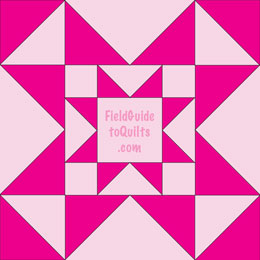 8 Hands Around
LAC #149 8 Hands Around
LAC #149
1897
Another LAC block from 1897, this time #149.
"Eight hands around" is a basic square dance "call," or instruction, to the four couples in a square dance grouping. It tells the eight dancers to hold hands and walk in a circle while they await the next call.
There are at least four other blocks named 8 Hands Around, but only one resembles the LAC's, and that is designer Nancy Cabot's, below. |
|
Eight Hands Around
 Eight Hands Around
Cabot Eight Hands Around
Cabot
1937
   
   
   
   
Eight Hands Around Castle Garden
Designer Nancy Cabot's version of Eight Hands Around was published in the Chicago Tribune in 1936, and again in 1937 as Castle Garden. It amounts to a Sawtooth within a Sawtooth, with embellishments in the form of extra triangles.
Castle Garden was the U.S. immigrant intake center in New York City from 1855 until 1890, when Ellis Island opened. The walls of Castle Garden are in Battery Park and a must-see for tourists on their way to Liberty Island.
Our whole-quilt mockup of the block, because it has 16 blocks, approaches Op Art in its demands on the eyes. In fact, the block is complex enough that a single block could make a respectable whole quilt for those short-notice baby shower gifts and such.
|
|
Free Trade Block
 Free Trade Block
Finley Free Trade Block
Finley
1929
 Free Trade Block Free Trade Patch/Coronation Free Trade Block Free Trade Patch/Coronation
Until the income tax came along in 1913, tariffs paid up to 90 percent of the U.S. budget. In 1861, the Republican party decided that tariffs should be higher, a position they maintained for 60-odd years.
The quilter who invented this block apparently disagreed, but we don't know when — just that it could have been before the Civil War, when the country imposed tariffs on Britain that hurt the South's economy. The South provided raw materials, mainly cotton, to British fabric makers.
Free trade was a Democratic cause, and most southerners were Democrats. If we were weaving a tale, we'd lay the block design at the feet of a furious cotton-grower's wife, but we don't know the facts.
The name Free Trade Block is from Ruth Finley (1929); Free Trade Patch is from Carrie Hall (1935).
It was columnist Nancy Page who came up with the name Coronation in 1937. That was the year Britain's George VI was crowned, taking the place of Edward VIII, who had abdicated to marry the American divorceé Wallis Simpson. While some swooned, others shrugged: For one coronation portrait, the artist simply painted George's head over Edward's.*
*Daily Mail (January 3, 2012)
|
|
Winged Four Patch
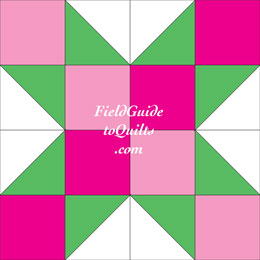   
   
   
   
Winged Four Patch
 Winged Four PatchKCS, 1952
The Kansas City Star's 1952 block called The Winged Four Patch has the key shapes (in green in our graphic) for a Sawtooth, but it also creates a diagonal look when it's set in a group. Winged Four PatchKCS, 1952
The Kansas City Star's 1952 block called The Winged Four Patch has the key shapes (in green in our graphic) for a Sawtooth, but it also creates a diagonal look when it's set in a group.
Shown with the Star's colors, the block should be all prints except for the pieces in dark pink and white.
|
|
Solitaire
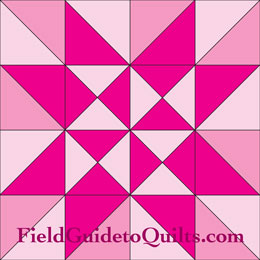 Solitaire Solitaire
Stone
1906
You could say that within the Sawtooth is a Yankee Puzzle block. Those four four-triangle squares in the middle are made up of quarter-square triangles. For more, click here: 
|
|
Sarah's Choice
 Sarah's Choice Sarah's Choice
Stone
1906
We call that four-piece square in the middle a windmill after another block of that name. In real life, it has no definitive name that we know of.
|
|
Anna's Choice Quilt
 Anna's Choice Anna's Choice
Stone
1906
The right triangles that make up the corner squares are called half-square triangles, and you can see the difference they make in the whole-quilt mockup. Anna's Choice, in two colors, can easily be used as a scrap quilt without any loss to the busy pattern of the quilt top.
The block's colors make it look identical to Pin Wheel and Polk Ohio, but Anna's Favorite split those single-color diamond-shaped pieces that meet at the center. That makes Anna's Choice a Sawtooth in our book. |
|
|
 |
|
 Sawtooth & variations
***
Sawtooth & variations
***














 Joining Star
Joining Star
 Ribbon Star
Ribbon Star Star in a Star
Star in a Star 8 Hands Around
8 Hands Around Eight Hands Around
Eight Hands Around Free Trade Block
Free Trade Block  Free Trade Block
Free Trade Block Solitaire
Solitaire
 Sarah's Choice
Sarah's Choice
 Anna's Choice
Anna's Choice